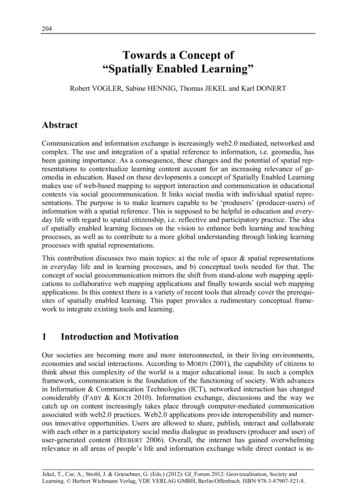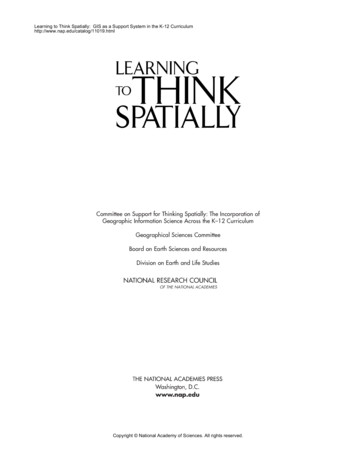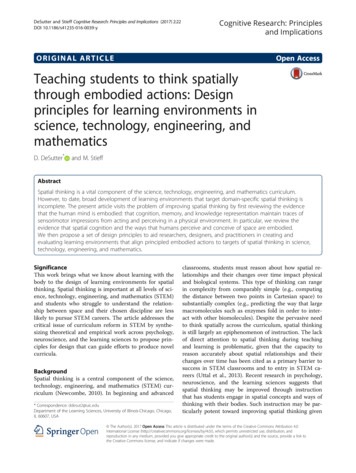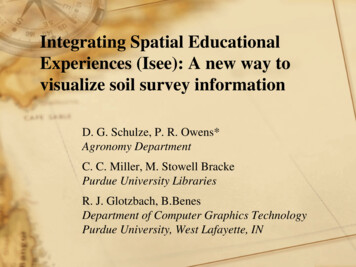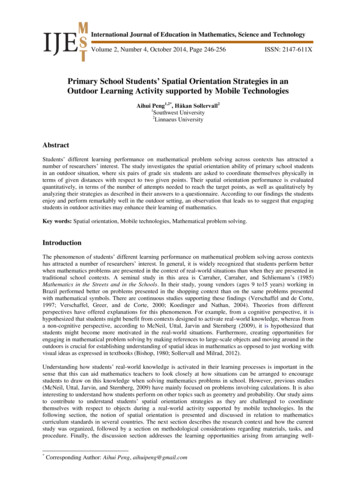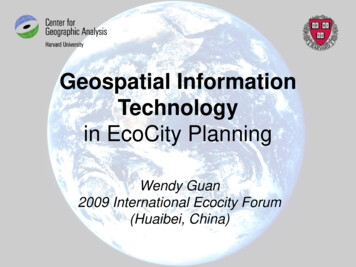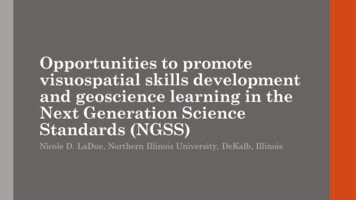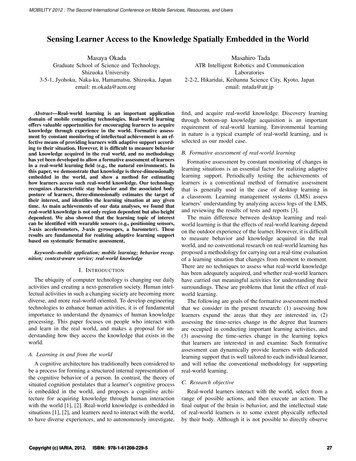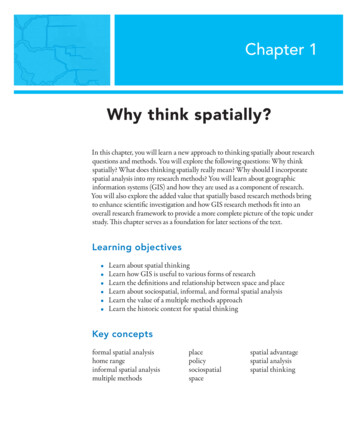
Transcription
Chapter 1Why think spatially?In this chapter, you will learn a new approach to thinking spatially about researchquestions and methods. You will explore the following questions: Why thinkspatially? What does thinking spatially really mean? Why should I incorporatespatial analysis into my research methods? You will learn about geographicinformation systems (GIS) and how they are used as a component of research.You will also explore the added value that spatially based research methods bringto enhance scientific investigation and how GIS research methods fit into anoverall research framework to provide a more complete picture of the topic understudy. This chapter serves as a foundation for later sections of the text.Learning objectives Learn about spatial thinkingLearn how GIS is useful to various forms of researchLearn the definitions and relationship between space and placeLearn about sociospatial, informal, and formal spatial analysisLearn the value of a multiple methods approachLearn the historic context for spatial thinkingKey conceptsformal spatial analysishome rangeinformal spatial analysismultiple methodsEsir Steinberg.indb 1placepolicysociospatialspacespatial advantagespatial analysisspatial thinking3/6/15 4:59 PM
Using spatial knowledgeA headline on a local news website reads, “Westside Mugger Caught!” Given that you workon the Westside, you feel a great sense of relief as you begin to read the article. The past fewweeks have seen a rash of muggings; every couple of days, another victim was attacked, and itseemed as though the assailant was a step ahead of the police. You have always wondered howthe police catch up with criminals, and as you read the story, you come across a sentence thatpiques your interest: “We never would have caught the person behind these attacks withoutour new CompStat system,” stated the chief of police. The article goes on to explain thatCompStat is a computer-based analysis system built around crime statistics mapped in GIS.Interesting. You begin to wonder exactly what the journalist means by mapping crimestatistics. How would that help catch a criminal? You have always found maps to beinteresting, and they certainly help you find your way when traveling. You have even heardabout those maps to movie stars’ homes you can buy in Hollywood, but you don’t recall everseeing a map to criminals’ homes (figure 1.1).It turns out that the GIS behind CompStat wasn’t exactly used to find the home of thecriminal, but almost. The police took advantage of a variety of basic information, or data,about the area in which the crimes were occurring (figure 1.2), along with information aboutthe locations of each of the muggings as they were reported. As the locations of the crimeswere mapped, some interesting patterns began to develop.Figure 1.1 An example of a publicly available crime map from the Hollywood area of Los Angeles, California.This web-mapping site integrates crime data from police departments around the country and is powered by theEsri ArcGIS for Server. Courtesy of the Omega Group, San Diego, CA. Basemap data from Esri, HERE, DeLorme, IPC,METI/NASA, USGS, EPA.2GIS Research Methods: Incorporating Spatial PerspectivesEsir Steinberg.indb 23/6/15 4:59 PM
Figure 1.2The dashboard view provides detailed, specific crime information to police chiefs and precinctcommanders. Courtesy of the Omega Group, San Diego, CA.For example, all of the muggings occurred within two blocks of an ATM machine. Thatseems sensible to you; the mugger might well have been targeting people who were gettingcash. The attacks were always late in the evening, after ten o’clock, and the victims werealways confronted on streets that had little traffic. What streets don’t have lots of traffic atthat time of night? Perhaps residential areas, where folks are in bed? Maybe. But wouldn’tsomeone hear the commotion? A more likely area is around the financial district, whereeverything closes at five in the evening and there’s not a lot going on at night.You start to realize that by looking at some basic map information, you might be ableto narrow down areas that meet a particular profile that seems to be developing. But as youthink about it, you wonder, “Aren’t there lots of areas on the Westside where there’s littleactivity in business districts at that time of night? And ATMs? It seems there’s one onalmost every corner. What else could have helped the police get the bad guy?” It turns outthat the crimes were clustered in a ten-block area. Perhaps the mugger lives near that area, or,better still, he probably lives near the middle of that area, so he didn’t have to walk too far tofind his victims.Of course, the police knew other things that helped them narrow down the suspect.They knew who in that area had a record for mugging, robbery, burglary, or other similarcrimes. They knew if any recent parolees lived nearby. They may have had other clues that1 Why think spatially?Esir Steinberg.indb 333/6/15 4:59 PM
matched the modi operandi of known offenders. Odds are this wasn’t someone who woke upone day and decided to become a mugger—someone like this probably has a history.As you ponder all this, you begin to understand how a system like CompStat would beso helpful. Of course, if you could somehow put all of these data together on a map, definingareas that meet the given criteria, you might be able to narrow the search area down tosomething manageable. Sure, you might not come up with the criminal’s home address, butyou would certainly know where to put extra police on the beat to catch him. But one thingstill bothers you: the complexity of getting all of this information onto a map and doing theanalysis to get to this point. Wouldn’t that be a major task? It was hard enough for you todraw a readable map for your friends to find their way to your new apartment for your lastSuper Bowl party! It’s much easier to direct your friends to one of the many online mappingtools to find your house.It must be that computer thing the police chief mentioned in the article, that geographicinformation system, that performs such a complex task. It all sounds very complicated. Butyou are intrigued and want to find out more about these geographic information systems.Maybe they could be useful in other ways. After all, if you can use them to narrow downlocations of criminals, what other kinds of analysis might they be useful for?What is GIS?Although you may already have some familiarity with what GIS is, it is useful to startwith a definition. A geographic information system (GIS) is a specialized computerdatabase program designed for the collection, storage, manipulation, retrieval, andanalysis of spatial data. GIS provides far more than the ability to create maps; althoughmaps are a common output of GIS, they are not the only outcome of analysis, andsometimes not even an essential end product. If this surprises you, consider that GIStechnology was originally developed in the 1960s, when computer graphics werevirtually nonexistent and output was more often printed on hard copy than displayedon monitors. GIS serves as a powerful data collection, organization, exploration, andanalysis tool that can assist the researcher in multiple ways. Perhaps its greatest value liesin its ability to help us understand, draw parallels, and see connections between factorsand/or variables with an eye for spatial relationships: understanding any situation,problem, or issue necessitates gaining information, and the best way to gain informationis through a variety of channels, not by relying on a single source of information thatcould be error filled. The next section explores what is meant by the term GIS, whichfacilitates spatial thinking.4GIS Research Methods: Incorporating Spatial PerspectivesEsir Steinberg.indb 43/6/15 4:59 PM
In its simplest form, GIS is designed to store, manipulate, analyze, and output map-based,or spatial, information. In practice, the functions of GIS can be carried out by hand, usingonly paper, pencil, and a ruler (as a surprising number of people still do). Of course, this is notpractical or efficient for many research applications.When we refer to spatial information or data, we mean that the information is linked toa specific location, such as a street address. Figure 1.3 provides an example of a real-life viewof the world, as represented in an aerial photograph. This photograph is tied to associateddata about the world similar to what you might collect or analyze in a study. These tabulardata are related to the world via their location.Figure 1.3 On the left is an example of a US Geological Survey (USGS) aerial photograph of a suburban location. Thisshows the world in much the same manner as if you were looking out the window of an airplane. When collecting datain this area, you could record the area’s street address, census block, or neighborhood. These are examples of spatialinformation. On the right are tabular data associated with one surveyed household, as recorded on a survey form.Used together, spatial and tabular information would be useful in doing GIS-based analysis. Figure by Steven Steinberg,color infrared imagery, USGS National Aerial Photography Program (NAPP), Charleston, SC, acquired February 6, 2007.Although no single definition of GIS exists, GIS professionals do agree on somegeneral principles. First, GIS requires a combination of computer hardware andsoftware tools. Second, GIS requires data, and these data must possess a spatial orlocation component. Third, GIS requires knowledgeable individuals to develop thedatabase and carry out the data processing. Although GIS software has become mucheasier to use since the introduction of graphical user interfaces, GIS programs, and1 Why think spatially?Esir Steinberg.indb 553/6/15 4:59 PM
much of the underlying geographic theory, require people to have a basic understandingof maps and map analysis. Anyone with a little basic computer knowledge, which wediscuss in this book, can accomplish most GIS tasks. However, for more complex dataand analysis, it is often helpful to work with a GIS analyst with in-depth knowledge ofGIS and data.Last, and perhaps most important, GIS is a system for analysis; that is, GIS is useful forexamining, displaying, and outputting information gleaned from the data that are storedand maintained in the system. This book explains the necessary mapping concepts andspatial analysis you need to do GIS-based research.Understanding geographic information systemsTo best understand a GIS, you need to understand GIS terminology and how GIS apply tovarious analysis situations. In particular, how can your area of interest and the associateddata be placed into a GIS context? How can GIS technology enhance your analysis andunderstanding of data? You can use GIS to study issues with real data as well as conceptualdata. The concept of space exists in different dimensions: the actual and the perceived. Spaceis defined as distance and time between locations and is often used to determine position.For example, an interview script asking individuals about their homes, communities,relationships, or other interactions inevitably will include phrases such as “in ourneighborhood,” “around the corner,” or “over in the next valley.” While investigating socialrelationships, you might come across examples of conceptual geography. For example, thestrengths of social ties between individuals might be represented in statements such as“I’m very close to my younger brother” or, conversely, “We found ourselves drifting furtherapart with each passing year.” These statements, although not tied to physical locations,nonetheless may be mapped and analyzed using many of the same techniques that one mightapply in traditional GIS analysis.A new approach to research methodsThe value of spatial relationships, patterns, and connections represented with mapshas a long history in many disciplines across the natural and social sciences. However,it is only more recently that we can take this information and put it all into acomputer analysis environment using GIS, which can account for and analyze space inmeaningful ways.6GIS Research Methods: Incorporating Spatial PerspectivesEsir Steinberg.indb 63/6/15 4:59 PM
Everyone thinks spatially on a daily basis. At the beginning of the day, when we navigateour way to work, school, or the grocery store, we think about our destination and howbest to reach it. This spatial thinking occurs in our minds, based on our knowledge ofthe surrounding environment (figures 1.4 and 1.5). We may choose a route to a particulardestination based on what is most familiar or what we have found to be the most effectivepath in the past.Figure 1.4 A map of essential landmarks from the perspective of our son at age seven. This map features locationshe found important at the time, including our home, his school, parks, and other significant locations. Geography isnot accurately represented for either distance or direction from home. However, features closer to home (to whichhe has personal experience walking or riding his bike) are more accurately represented than those that must bereached as a passenger in a car. Map courtesy of Joshua Steinberg, 2011.1 Why think spatially?Esir Steinberg.indb 773/6/15 4:59 PM
Figure 1.5A view of the same region represented in figure 1.4 as a map built with ArcGIS software with USGSbasemap data. The landmarks highlighted in our son’s map actually stretch across a region in excess of 300 squarekilometers. Map courtesy of Steven Steinberg. Data from USGS.When you are in a new place or city and do not know where you are, how do youfind your way to where you want to go? You could rely on digital technologies, such asGlobal Positioning System (GPS) (figure 1.6) or web-based mapping tools, to assist youin finding your way to a specific location. You could get there by following a paper map(figure 1.7), although not many people do that anymore. You could find your way byasking local people for directions. Asking for directions will most likely produce a varietyof answers, depending on whom you ask and that person’s own experience with traveland mobility in the city.8GIS Research Methods: Incorporating Spatial PerspectivesEsir Steinberg.indb 83/6/15 4:59 PM
1 Why think spatially? 5 In its simplest form, GIS is designed to store, manipulate, analyze, and output map-based, or spatial, information.In practice, the functions of GIS can be carried out by hand, using only paper, pencil,
